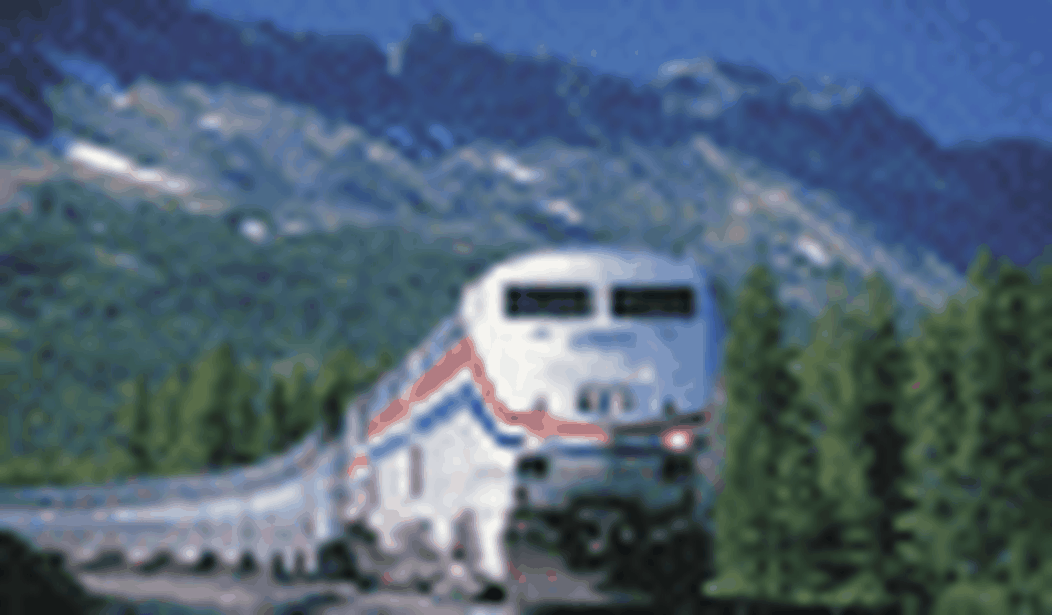I just want to make it clear from the outset: I love trains. When I lived in New York and Connecticut, I rode trains regularly, just because I like them; they’re far more comfortable that flying, and you don’t have the hassles. I could walk to Penn Station, walk onto a train, and be in Washington or Boston or Hartford or Pittsburgh in a few hours, with pleasant scenery and the real chance of pleasant companionship. When I lived in Germany, I used the train to visit my employer’s home office in Paris: I could pick up the Schlafwagen in Basel, sleep overnight, and be in Paris when I woke up. My grandfather was part owner of the shortest main-line railroad in the world; when my peers were playing with toy trains, I was playing on a real 2-8-0 Baldwin steam engine built in 1890. I really like trains.
So when Megan McArdle says “America’s freight rail system … is world-class. Its passenger rail should be too,” I’m naturally inclined to agree with her. It positively breaks my heart to have to say “no, actually it shouldn’t. Passenger rail is almost certainly never going to work again, at least as a national transport system.”
As usual, what’s thwarting my dreams of elegant dinners in the first-class dining car with Myrna Loy is arithmetic. Well, that and the fact that Myrna Loy died in 1993. Let’s just compare passenger trains and airplanes on three trips I’m likely to take for business in the next few months: Denver to Los Angeles, Denver to New York City, and Denver to Washington, DC.
| TRIP | Train | Train | Plane | Plane | Den-DC | $554 | 74 hours | $410 | 16 hours | $1,778 (roomette) |
|---|---|---|---|---|
| Den-LA | $426 | 54 hours | $179 | 12 hours |
| $1,232 (roomette) | ||||
| Den-NYC | $655 | 90 hours | $428 | 18 hours |
| $2,002 (roomette) |
For purposes of comparison, I’m taking cost and travel time from the Amtrak website and the Frontier Airlines website, traveling to arrive at the destination city on July 15, 2008, and leave for home on July 18; if there are any options, I’m taking the least expensive routing. Travel times are totaled for the round trip, and include three hours per flight added for getting to the airport and getting through security, and transit time from the airport to and from the city center on each trip. Notice, by the way, that this gives trains an inherent advantage, since the train station is usually in the city center.
The table tells the tale, I think. The train is from one and a half to five times as expensive, and takes four and a half to five times as long, turning a four-day trip into seven or eight days.
I can imagine taking the train to New York on vacation, because I am a train nut and the trip would be fun in itself. But let’s think about this as a business trip: taking the train would not only cost about 1.5 times as much — or four times as much with a compartment, and I’m just sure I’d be all set to go right to work in New York after two full days in a coach seat — but it consumes four working days in travel time. I can manage a one-day business trip by plane, but a one-day trip to New York by train is a five-day trip. Subsidies won’t help: counting in the lost time, Amtrak would have to pay me $4,000 to make up for the time difference. The travel time difference is so large that Amtrak couldn’t compete if train tickets were free.
So why are trains so popular in Europe? Simple: Europe is smaller. My Basel to Paris trip is 250 miles; Denver to New York is 1,625 miles. Why is Amtrak popular in the Northeast? Because, here we go, the distances are comparable to Europe: Washington, DC, to New York is 203 miles.
To make train travel competitive, you’d need to raise airline ticket prices about 15 times, say with an excise tax or a tariff. Raising the airline ticket prices 15 times would, of course, pretty well end the airline industry as we know it; rock stars and CEOs would be about all that was left. Although I suppose they’d give their occasional traveler a second bag of peanuts if asked.
New technology won’t help all that much for a nationwide system, either. The French TGV train — I love French: train à grande vitesse just sounds so much inherently cooler than “really fast train” — really only travels about 200 miles an hour; even maglev trains are not a lot faster. That would cut the travel time in half, making the total travel time to New York only, hoo-hah, 45 hours.
It’s not a matter of the government not supporting Amtrak. It’s not a matter of the U.S. not having the “will” to have the best passenger trains in the world. It’s that passenger trains, using any current technology or any technology we see coming in the foreseeable future, simply can’t compete with airlines.
It’s just arithmetic.








Join the conversation as a VIP Member